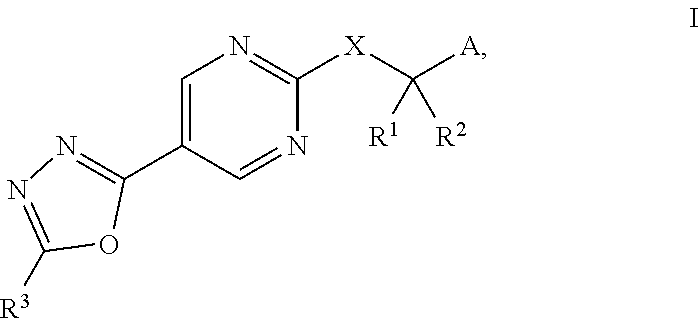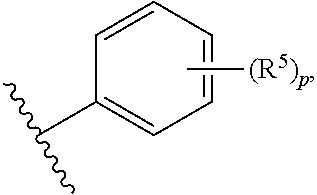Metalloenzyme inhibitor compounds
a technology of metalloenzyme inhibitors and compounds, applied in the field ofmetalloenzyme inhibitor compounds, can solve the problems of non-selectivity of the target enzyme versus the related metalloenzyme, ineffective potency, and dramatic decrease of the activity of the enzyme, and achieve the effect of improving the pharmacokinetic profil
- Summary
- Abstract
- Description
- Claims
- Application Information
AI Technical Summary
Benefits of technology
Problems solved by technology
Method used
Image
Examples
example 1
N-(1-phenylcyclopropyl)-5-(5-(trifluoromethyl)-1,3,4-oxadiazol-2-yl) pyrimidin-2-amine (1)
[0892]
1-phenylcyclopropan-1-amine (B)
[0893]To a stirred solution of benzonitrile (A, 5.0 g, 48.54 mmol) in diethyl ether (50 mL), ethyl magnesium bromide (3M, 34.20 mL, 106.7 mmol) and titanium isopropoxide (15.16 g, 53.39 mmol) were added at −70° C. and the reaction was stirred at RT for 2 h. BF3.OEt2 (13.77 g, 97.08 mmol) was added at 0° C. and stirred at RT for 8 h. The progress of the reaction was monitored by thin layer chromatography (TLC). After completion of the reaction, the reaction mixture was quenched with NH4Cl solution and basified with 10% NaOH solution, extracted with 10% (MeOH / DCM). The combined organic layer was washed with brine, dried over anhydrous Na2SO4 and concentrated under reduced pressure. The crude product was purified by silica gel column chromatography 50% EtOAc / hexane to afford compound B (5.0 g, 38.7%) as a pale-yellow liquid. 1H NMR (400 MHz, DMSO-d6) δ 7.32 (m,...
example 2
N-(1-phenylethyl)-5-(5-(trifluoromethyl)-1,3,4-oxadiazol-2-yl)pyrimidin-2-amine (2)
[0898]
5-bromo-N-(1-phenylethyl) pyrimidin-2-amine (G)
[0899]To a stirred solution of 5-bromo-2-chloropyrimidine (C, 5 g, 26 mmol) in EtOH (20 mL), 1-phenylethan-1-amine (6.26 g, 52 mmol) in DIPEA (30 mL) was added at 90° C. and the reaction mixture was stirred at 90° C. for 14 h. The progress of the reaction was monitored by TLC. After completion of the reaction, the reaction mixture was cooled to RT and concentrated under reduced pressure. The crude product was purified by silica gel column chromatography using 10% EtOAc / hexane to afford compound G (6 g, 83.68%) as a white solid. LC-MS: m / z 277.9 [M+H]+.
2-((1-phenylethyl)amino)pyrimidine-5-carbonitrile (H)
[0900]To a stirred solution of compound G (4 g, 14 mmol) in DMF, Zn(CN)2 (2.52 g, 21 mmol) was added and purged with argon for 20 min. Pd(PPh3)4 (1.61 g, 1.4 mmol) was added and again purged with argon for 20 min and then stirred at 120° C. for 14 h....
example 3
N-((6-methylpyridin-2-yl) methyl)-5-(5-(trifluoromethyl)-1, 3, 4-oxadiazol-2-yl) pyrimidin-2-amine (3)
[0903]
5-bromo-N-((6-methylpyridin-2-yl)methyl)pyrimidin-2-amine (J)
[0904]To a stirred solution of (6-methylpyridin-2-yl)methanamine (0.2 g, 1.63 mmol) in ethanol (5 mL), 5-bromo-2-chloropyrimidine (C, 0.4 g, 2.07 mmol) and DIPEA (0.9 mL, 4.91 mmol) were added and the reaction mixture was heated to 90° C. for 4 h. The progress of the reaction was monitored by TLC. After completion of the reaction, the reaction mixture was concentrated under reduced pressure. The crude product was purified by silica gel column chromatography using 10% EtOAc / hexane to afford compound J (0.15 g, 32%) as an off white solid. LC-MS: m / z 278.95 [M+H]+.
2-(((6-methylpyridin-2-yl) methyl) amino) pyrimidine-5-carbonitrile (K)
[0905]A stirred solution of compound J (0.15 g, 0.53 mmol) and Zn(CN)2 (0.28 g, 2.42 mmol) in DMF (2 mL) was purged with argon for 20 min and then Pd(PPh3)4 (0.093 g, 0.08 mmol) was added. ...
PUM
| Property | Measurement | Unit |
|---|---|---|
| Temperature | aaaaa | aaaaa |
| Molar density | aaaaa | aaaaa |
| Molar density | aaaaa | aaaaa |
Abstract
Description
Claims
Application Information
 Login to View More
Login to View More - R&D
- Intellectual Property
- Life Sciences
- Materials
- Tech Scout
- Unparalleled Data Quality
- Higher Quality Content
- 60% Fewer Hallucinations
Browse by: Latest US Patents, China's latest patents, Technical Efficacy Thesaurus, Application Domain, Technology Topic, Popular Technical Reports.
© 2025 PatSnap. All rights reserved.Legal|Privacy policy|Modern Slavery Act Transparency Statement|Sitemap|About US| Contact US: help@patsnap.com



